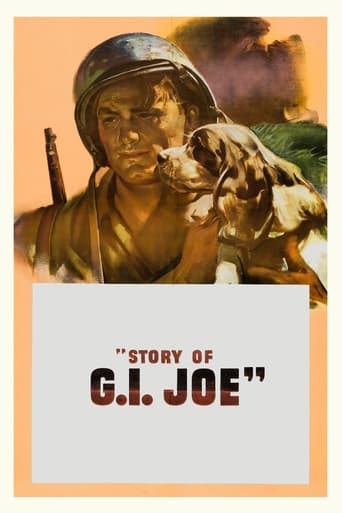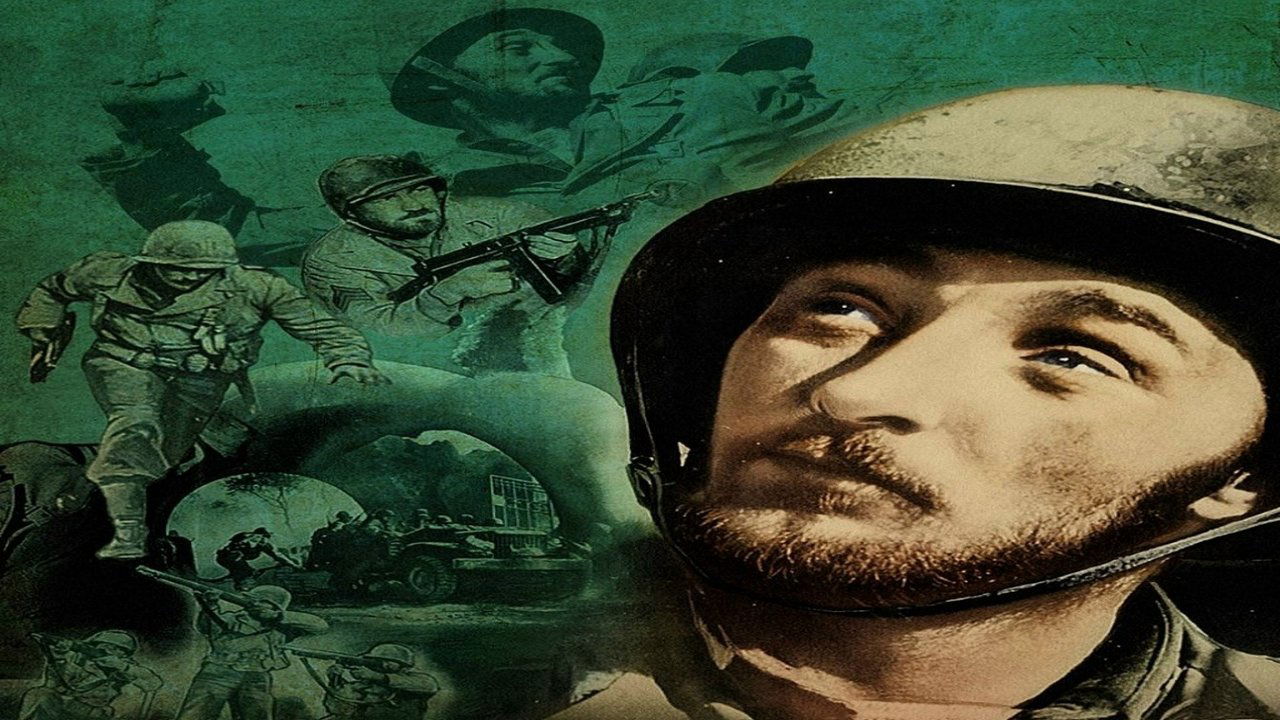billcr12
I am currently reading an excellent biography of Robert Mitchum, "Baby I Don't Care." The book led me to this movie. Mitchum is Captain Walker. He leads his ground troops through Italy, on their way to Rome while fighting Germans during WWII. The story is based on Pulitzer Prize winning journalist Ernie Pyle's coverage of the war. Pyle was a consultant on the set which used real military personnel to maintain authenticity. Burgess Meredith is Ernie Pyle and he is well cast. Meredith and Mitchum are tremendous and a scene about 3/4 of the way into the film is the height of this gritty war story. Captain Walker is writing the standard sorry to inform you letters to families back in America when Pyle joins him for a drink from a bottle of Grappa. They discuss the endless rounds of battle and death with more and more kids sent to die for their country. Mitchum received his only Oscar nomination but did not win. It is a shame, as he was a vastly underrated actor. G I Joe has an emotional impact which caused Dwight Eisenhower to call it the greatest war film he he had ever seen. I agree.
SimonJack
This movie was and is a testimonial to the American fighting men of World War II. It came out as men were still fighting and dying in that war. It is a film about the ordinary guy, the grunt, the G.I., the infantryman. "The Story of G.I. Joe" came from the columns of war correspondent Ernie Pyle. After 30 months of covering the war from North Africa to Europe, Pyle was on a self-imposed rest (or he would crack up, he said). Pyle visited the set and watched Burgess Meredith in his role. But he was soon off again to cover the war – this time in the South Pacific. Yet, he wouldn't live to see this movie. Ernie Pyle was killed April 18, 1945, by Japanese machine gun fire. He had gone ashore with the 305th Infantry Regiment on a small island near Okinawa. So, this film is as much a story about Ernie Pyle. He was just an ordinary guy himself, and an ordinary correspondent. Yet his style and method and interest in the every man set Pyle apart. He was someone very special, who wrote about all these other ordinary men who themselves were so special to others – to someone else back home, and to their fellow G.I.s. People across America read Pyle's column in the more than 300 newspapers that ran it. He wrote six installments each week. Others reported on the battles and progress of the war. Pyle wrote about the G.I.s living it and fighting it. He wrote plainly, simply and humbly – suiting the men, the situations, the conditions and himself – as they were. He was lauded by generals, a friend to the G.I.s, and loved by the people back home. "The Story of G.I. Joe" is indeed a great movie. It's an account, like no other war movie has come close to showing, of the drudgery, grime, exhaustion, cold, wet, sleeplessness, loneliness, longing and misery of the common fighting man. This is a reality look at the existence of the infantry soldier. With all of that, it's as good an anti-war film as one will find. Yet it doesn't denigrate the men who must fight a war. The cast all are excellent. They are based on real people. Only their names have been changed. Robert Mitchum plays Captain Walker, whose character is that of the real Capt. Henry Waskow of Belton, Texas. This was a breakout role for Mitchum that led to his stardom. He had been in more than two dozen films since 1943, mostly with bit parts. This is one of his best performances. Mitchum received his only Oscar nomination for this role. Burgess Meredith apparently had a physique and personal demeanor similar to Pyle, so he was a natural for that role. Freddie Steele is superb as Sgt. Warnicki. His role, as well, was worthy of nomination for the supporting actor Oscar. Wally Cassell is very good as Pvt. Dondaro and Bill Murphy is very good as Pvt. Mew.The movie makers did a superb job in creating the terrain and battlefield conditions for this movie. The actors truly seemed bedraggled and worn out. They trudged through rain and mud, grew beards and ate cold, canned C rations. This appeared to be as unlike Hollywood as imaginable. It was a nod to the G.I.s who really lived the experiences. Pyle had been a top newspaper managing editor, but he preferred writing about people, so he resigned to become a correspondent. From 1935 through 1941, he traveled across America writing about people in a Mark Twain style. When America entered the war, he became a war correspondent. But, he left the reporting of battles and big stuff to other writers. He wrote about the G.I.s he met.The unit Pyle tags along with in most of this film is Company C of the 18th Infantry Regiment. While there is such a military unit, it wasn't active then. For this film, it's fictitious. From North Africa to Sicily and Italy, Pyle covered the 3rd, 36th and 45th Infantry divisions and the Fifth Army. After the Italian campaign, he went to England to cover the Allied invasion of Normandy on D-Day. He was at the liberation of Paris in August 1944, and on Sept. 5, 1944, he apologized to his readers that he had to take a rest to keep from having a breakdown. Ernie Pyle was a Navy veteran of WW I, but in the Pacific theater, he wrote that Navy crews had an easy life compared to the infantry soldiers. Some thought he gave the Navy short shrift, but he did cover the navy in the taking of Okinawa. Yet, he said his heart was with the men in the foxholes and slogging through mud in the rain and cold. Pyle won the Pulitzer Prize for correspondence in 1944, as the film shows. That year he caught up with his old unit again. The men all have become seasoned veterans by now. Pyle asks Capt. Walker about them. Walker says, "They're the best, Ernie. They're the best." Pyle, "Yep. It's a world the other world will never know. Even the Air Force. Up there, they approach death differently. When they die, they're clean-shaven, well fed, if that's any comfort. But the G.I., well, he lives so miserably and he dies so miserably
." The film doesn't show it, but Pyle wrote about the captain's death in his next column. "In this war I have known a lot of officers who were loved and respected by the soldiers under them. But never have I crossed the trail of any man as beloved as Capt. Henry T. Waskow of Belton, Texas."The film has no vulgar language, but it has some humor. Sgt. Warnicki, "That reminds me of W.C. Fields' sure cure for insomnia. Get plenty of sleep."
Alex da Silva
I wanted to like this film but it fails to ignite. It started badly for me, I'm afraid with two mega No-No's for wartime. The first is the introduction of a pet – absolutely should not be allowed. So what we get is a bit of sappy sentimentalism for the animal. We also get the introduction of a journalist coming along for the ride – absolutely should not be allowed. Another hindrance to the troops who are fighting in life or death situations. I wish warfare wasn't conducted in this manner, ie, thoroughly stupidly with journalists given responsibility. Surviving soldiers can report their tales if you want to hear about what happened. To make things worse, we also get another sentimental scene where soldiers turn on the radio and listen to a sentimental song which is being used as propaganda. Absolutely not. Turn the radio off – this is not the right frame of mind for soldiers who are fighting a war.That's already three pieces of irritating nonsense associated with this film. Add to this some irritating characters and some non-entity characters such as Mitchum. The film drags.
Havan_IronOak
This film is an odd mix. In spots the dialog and situations are cornier than Capra. But it is the first real attempt to depict (at least in part) some of the day to day hardships of the regular GI.Since the war was still on when this picture was made (released in 1945), the message had to be at least somewhat hopeful and yet it struck a mix not unlike some of Pyle's dispatches from the front. It certainly feels much more realistic than some earlier efforts like In Which We Serve (1942) The idea of filming on location hadn't been adopted yet, and the North Africa scenes filmed in California have a "wrongness" about the feel that hurts the early scenes in the picture. Also, some anachronisms in the equipping of the GI's will stand out as well to anyone familiar with newsreel footage or some of the better made documentaries that have been made since. The later footage that is supposed to be in Italy doesn't suffer as much from the lack of actual locations.Much of the picture revolves around an effort to get past a mountain guarded by an ancient monastery. The film somewhat rewrites history at this point in an attempt to exorcise some of the errors in judgment that later came to be associated with the bombing of Monte Cassino.Several filmic techniques are used a bit heavy handedly as well. Care is taken to keep the Germans a faceless, inscrutable foe. There is one scene where the lighting is very dramatically (and somewhat obviously)arranged so that a dark shadow is cast by a captured German's helmet. We don't have to see much of his face and certainly not his eyes.The use of the puppy is a bit overdone. Using a puppy to whine when we should be feeling sad is a bit heavy handed. Conversely the filmic trick of using the noise of nearby explosions to cover/censor one soldier's lewd comments is done with a wink and a nod to the audience. It's clear that film makers knew we'd get the joke. Since it was wartime, no American soldiers were shown too terribly mangled or with graphic / disturbing injuries. Rapid jump cuts were used very effectively in several key battle scenes to heighten the tension without having to overdo the special effects.One plot element was a bit weird though. A GI receives a record containing his son's first recorded words. The GI has never heard his kid speak and tries repeatedly to get the record to play on a phonograph that he "liberates" For some inexplicable reason the recording seems to have been recorded backwards so that all the GI can hear is garbled. Yet at one crucial moment he tries again and the recording this time seems to play fine despite it being obvious that he's done nothing differently. A bit more care in staging this could have made it actually work.Another thought that occurred to me several times while watching this picture was that while regular GI's were overseas actually fighting and dying for their country. The actors and crew involved in this film were safe at home. I've seen many other pictures made during war-time but somehow the confluence of this picture's message and the facts that I now know in retrospect made that somewhat jarring.Overall, I found this film to be WORTH watching but it didn't engage me the way that more well made films have. Still, releasing this shortly after Ernie Pyle's death in combat must have helped make it as successful as it was.



 AD
AD
